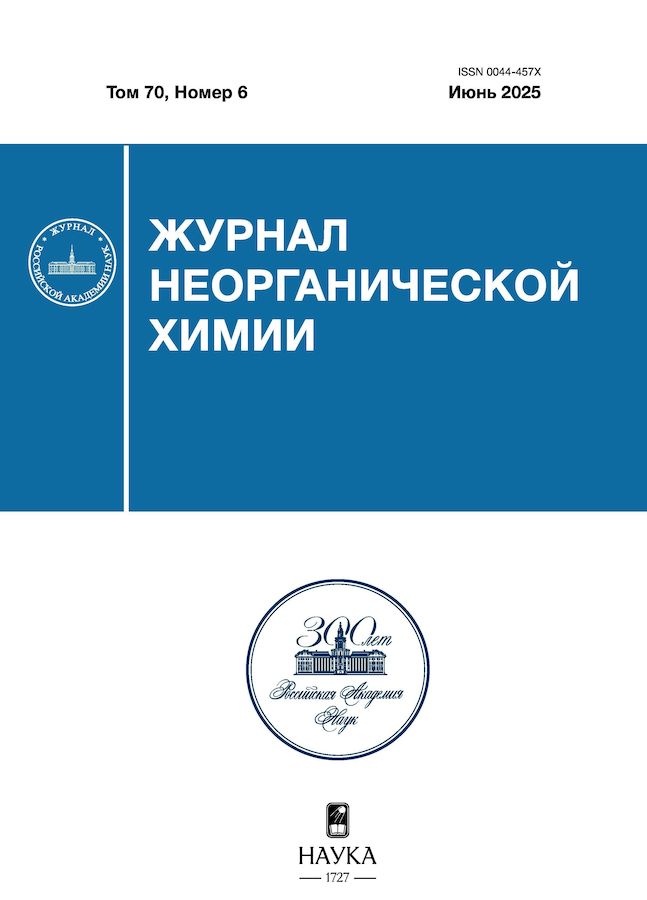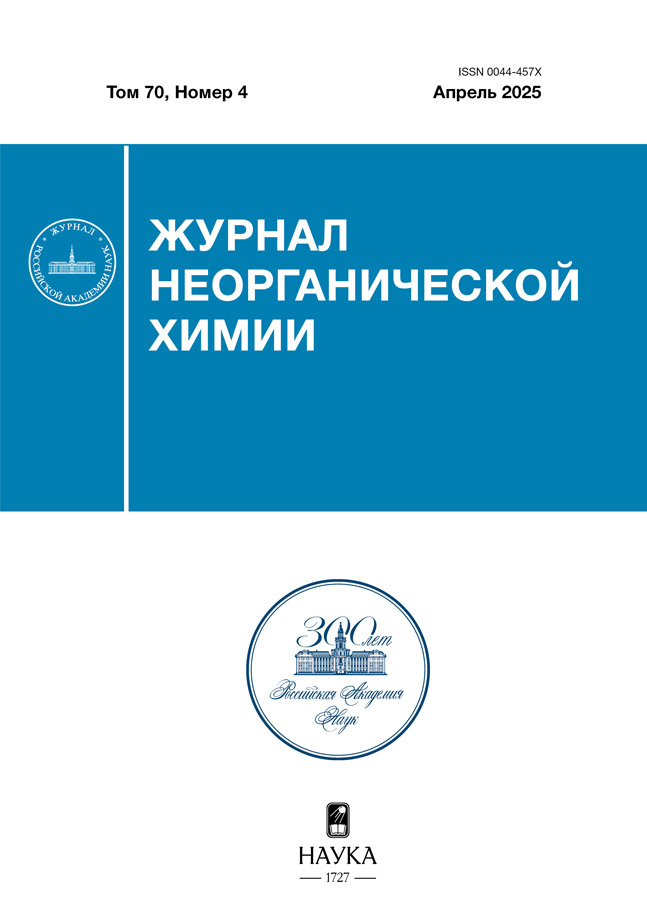Synthesis of TiO₂ nanopowder by thermal decomposition of titanium peroxo complex in the presence of NaCl as a template
- Authors: Shishmakov A.B.1, Mikushina Y.V.1, Koryakova O.V.1
-
Affiliations:
- Postovsky Institute of Organic Synthesis, Ural Branch of the Russian Academy of Sciences
- Issue: Vol 70, No 4 (2025)
- Pages: 597-605
- Section: НЕОРГАНИЧЕСКИЕ МАТЕРИАЛЫ И НАНОМАТЕРИАЛЫ
- URL: https://ta-journal.ru/0044-457X/article/view/687076
- DOI: https://doi.org/10.31857/S0044457X25040134
- EDN: https://elibrary.ru/HPIGYF
- ID: 687076
Cite item
Abstract
Dispersed titanium dioxide was synthesized by thermal decomposition (700°C) of titanium peroxo complex in the presence of sodium chloride as a template at different precursor/template ratios. Its comparative analysis was carried out with titanium dioxide obtained in the absence of a template. Titanium dioxide is represented by two crystalline phases - anatase and rutile. It has been established that the presence of sodium chloride during the synthesis of nanodispersed TiO₂ leads to the formation of an aggregate of spherical TiO₂ crystallites with an average diameter of 19 nm. The dominant crystalline phase is anatase (>90%). With an increase in the NaCl content in the initial mixture, an increase in the proportion of the <15 nm crystallites fraction, an increase in the proportion of the anatase phase, and an increase in the Ssp value are observed.
Full Text
About the authors
A. B. Shishmakov
Postovsky Institute of Organic Synthesis, Ural Branch of the Russian Academy of Sciences
Email: Mikushina@ios.uran.ru
Russian Federation, st. S. Kovalevskaya, d. 22/20, Ekaterinburg, 620108
Yu. V. Mikushina
Postovsky Institute of Organic Synthesis, Ural Branch of the Russian Academy of Sciences
Author for correspondence.
Email: Mikushina@ios.uran.ru
Russian Federation, st. S. Kovalevskaya, d. 22/20, Ekaterinburg, 620108
O. V. Koryakova
Postovsky Institute of Organic Synthesis, Ural Branch of the Russian Academy of Sciences
Email: Mikushina@ios.uran.ru
Russian Federation, st. S. Kovalevskaya, d. 22/20, Ekaterinburg, 620108
References
- Лукутцова Н.П., Постникова О.А., Пыкин А.А. и др. // Вестн. БГТУ им. В.Г. Шухова. 2015. № 3. C. 54.
- Luévano-Hipуlito E., Martínez-de la Cruz A. // Constr. Build. Mater. 2018. V. 174. P. 302.https://doi.org/10.1016/j.conbuildmat.2018.04.095
- Verma R., Singh S., Dalai M.K. et al. // Mater. Des. 2017. V. 133. P. 10.https://doi.org/10.1016/j.matdes.2017.07.042
- Коботаева Н.С., Скороходова Т.С. // Химия в интересах устойчивого развития. 2019. Т. 27. № 1. С. 13.https://doi.org/10.15372/KhUR20190102
- Dudanov I.P., Vinogradov V.V., Chrishtop V.V. et al. // Res. Pract. Med. J. 2021. V. 8. № 1. P. 30.https://doi.org/10.17709/2409-2231-2021-8-1-3
- Ремпель А.А., Валеева А.А. // Изв. АН. Сер. Хим. 2019. V. 68. № 12. C. 2163.https://doi.org/10.1007/s11172-019-2685-y
- Бессуднова Е.В., Шикина Н.В., Исмагилов З.Р. // Альтернативная энергетика и экология (ISJAEE). 2014. Т. 7. C. 39.
- Губарева Е.Н., Баскаков П.С., Строкова В.В. и др. // Изв. СПбГТИ (ТУ). 2019. № 48. С. 78.
- Евсейчик М.А., Максимов С.Е., Хорошко Л.С. и др. // Журн. БГУ. Физика. 2023. № 2. C. 58.
- Yang J., Mei S., Ferreira J.M.F. // Mater. Sci. Eng. C. 2001. V. 15. № 1–2. P. 183.https://doi.org/10.1016/S0928-4931(01)00274-0
- Гаврилов А.И., Родионов И.А., Гаврилова Д.Ю. и др. // Докл. АН. 2012. Т. 444. № 5. С. 510.
- Khomane R.B. // J. Colloid Interface Sci. 2011. V. 356. P. 369.https://doi.org/10.1016/j.jcis.2010.12.048
- Sonawane R.S., Hegde S.G., Dongare M.K. // Mater. Chem. Phys. 2003. V. 77. P. 744.https://doi.org/10.1016/S0254-0584(02)00138-4
- Kobayashi M., Petrykin V., Tomita K. et al. // J. Ceram. Soc. Jpn. (JCS-Japan). 2008. V. 116. P. 578.https://doi.org/10.2109/jcersj2.116.578
- Krivtsov I., Ilkaeva M., Avdin V. et al. // J. Colloid Interface Sci. 2015. V. 444. P. 87.https://doi.org/10.1016/J.JCIS.2014.12.044
- Гейнц Н.С., Воробьев Д.В., Корина Е.А. и др. // Вестн. ЮУрГУ. Сер. Химия. 2021. Т. 13. № 2. С. 79.https://doi.org/10.14529/chem210208
- Яминский И.В., Ахметова А.И., Курьяков В.Н. и др. // Неорган. материалы. 2020. T. 56. № 11. С. 1221.http://doi.org/10.31857/S0002337X20110172
- Mendonça V.R., Lopes O.F., Avansi W. Jr. et al. // Ceram. Int. 2019. V. 45. № 17. P. 22998.https://doi.org/10.1016/j.ceramint.2019.07.345
- Montanhera M.A., Venancio R.H.D., Pereira É.A. et al. // Mater. Res. 2021. V. 24. P. 1.https://doi.org/10.1590/1980-5373-MR-2020-0377
- Savinkina E.V., Obolenskaya L.N., Kuzmicheva G.M. et al. // J. Mater. Res. 2018. V. 33. № 10. P. 1422.https://doi.org/10.1557/jmr.2018.52
- Nag M., Ghosh S., Rana R.K. et al. // J. Phys. Chem. Lett. 2010. V. 1. P. 2881.https://doi.org/10.1021/jz101137m
- Etacheri V., Seery M.K., Hinder S.J. et al. // Adv. Funct. Mater. 2011. V. 21. P. 3744.https://doi.org/10.1002/adfm.201100301
- Kobayashi M., Kato H., Kakihana M. // Nanomater. Nanotechnol. (NAX). 2013. V. 3. № 1. Р. 1.
- Баян Е.М., Лупейко Т.Г., Пустовая Л.Е. // Хим. физика. 2019. T. 38. № 4. C. 84.https://doi.org/10.1134/S0207401X19040022
- Ahn J.Y., Cheon H.K., Kim W.D. et al. // Chem. Eng. J. 2012. V. 188. P. 216.https://doi.org/10.1016/j.cej.2012.02.007
- Комаров В.С. // Вес. Нац. акад. навук Беларусi. Сер. хiм. навук. 2014. № 1. С. 16.
- Li N., An D., Yi Z. et al. // Ceram. Int. 2022. V. 48. № 2. P. 2637.https://doi.org/10.1016/j.ceramint.2021.10.047
- Zhu J., Wang B., Jin P. // RSC Adv. 2015. V. 5. P. 92004.https://doi.org/10.1039/C5RA18744C
- Liebertseder M., Wang D., Cavusoglu G. et al. // Nanoscale. 2021. V. 13. P. 2005.https://doi.org/10.1039/d0nr08871d
- Liu R., Yang S., Wang F. et al. // ACS Appl. Mater. Interfaces. 2012. V. 4. № 3. P. 1537.https://doi.org/10.1021/am201756m
- Raskó J., Kiss J. // Catal Lett. 2006. V. 111. № 1–2. P. 87.https://doi.org/10.1007/s10562-006-0133-8
- Mino L., Spoto G., Ferrari A.M. // J. Phys. Chem. C. 2014. V. 118. № 43. P. 25016.https://doi.org/doi.org/10.1021/jp507443k
- Shtyka O., Shatsila V., Ciesielski R. et al. // Catalysts. 2021. V. 11. P. 1.https://doi.org/10.3390/catal11010047
- Шишмаков А.Б., Корякова О.В., Микушина Ю.В. и др. // Журн. неорган. химии. 2014. Т. 59. № 9. С. 1210.https://doi.org/10.7868/S0044457X14090207
- Wu J.-M. // J. Cryst. Growth. 2004. V. 269. № 2. P. 347.https://doi.org/10.1016/j.jcrysgro.2004.05.023
- Shaporev V.P., Shestopalov O.V., Pitak I.V. // Sci. J. “ScienceRise”. 2015. V. 1/2. P. 10.
Supplementary files















